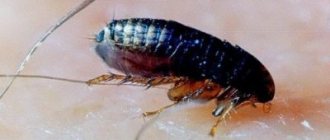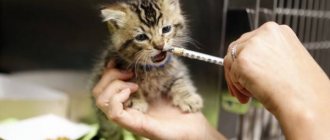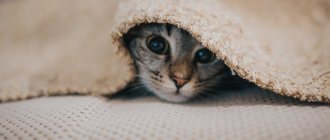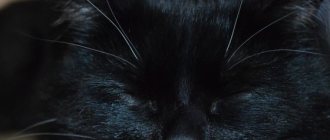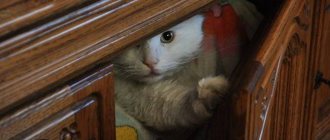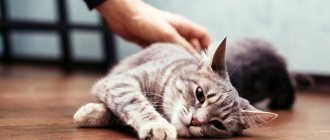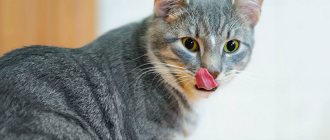Cats are one of the most popular pets today. These proud, independent animals attract with their tenderness towards their owners and genuine love, which cannot be earned, because if a cat loves, it is definitely not for something, but in spite of everything. Therefore, many owners study with interest the appearance and behavior of their charges. Some particularly attentive cat lovers are interested in where a cat’s belly button is. Think about it, has the same question ever crossed your mind? Do cats actually have a belly button? Today we’ll talk about this.
Where is
How to get a cat to eat if he refuses to eat
We must not forget that the difference in biological species means that the appearance of a cat's navel is noticeably different from a human's. The location of the navel is determined by examining the hair growing on the abdomen. It is located where it grows sparser and shorter. The navel is a small white scar. Of course, it is much easier to find it in a hairless or short-haired pet, but it occurs in any case.
Examination of the cat
How to find a cat's belly button
If the pet is already an adult, you need to put it on its back and examine the area on its stomach from the ribs to the beginning of the pelvic region. The cat's navel is located between the hind legs, closer to the nipples.
In most cases, detecting a cat's navel is complicated by physiological characteristics, for example, thick hair. Very attentive owners may notice a small spot that resembles lichen. In some individuals the spots may be pink and round, in others they may be irregular in shape.
Finding the navel quickly is possible in a small kitten. However, a good mother helps this part heal faster. Cat saliva contains important vitamins, they have a disinfecting effect. The navel may look like a point invisible to the human eye literally by the age of one month.
Important! The mark from the navel in an adult is practically invisible. This point does not differ in color from the main skin, and is also overgrown with hair.
How to find a cat's belly button
In a healthy cat, the remains of the umbilical cord, just like in a cat, almost completely disappear and should not stick out. This part of the body is noticeable only in newborn cats. The kittens' navel is bright pink and sometimes convex. With age, the navel becomes pale and lighter. In adult cats, this point is covered with hair, making it difficult to detect. Quick detection is possible if the animal has scanty fur or is completely bald.
Bald cat
You can try to lay a calm cat on its back and carefully examine its abdomen, namely the area near the ribs and pelvis. There is usually less fur at the point where the navel is located. The appearance may resemble a small scar. The cat's inguinal nipples can also serve as a reference point.
This is interesting: What to do when a cat shits on the bed
Does a cat have a belly button: where to look, does it exist at all?
In the article I will talk about cats’ navels and whether they have one. Let me consider its physiological significance. I’ll tell you where to look for this organ in a cat.
Cats are the most common pets. They have long won the world's love. But not all owners know some of the physiological characteristics of their furry friends. One of them is the cat's belly button. Where is it located and what function does it perform?
Does a cat have a belly button?
Often, the question of whether a cat has a belly button arises out of idle curiosity. It is important to know that all mammals have a navel, so representatives of the cat family also have one. It is not as pronounced as in humans, but you can still find it.
Where to look
We are used to the navel looking a certain way. In humans, it is like this because it is cut by an obstetrician. The cat, on the other hand, gnaws its own umbilical cord, its saliva has disinfecting and antibacterial properties, and fills the wound. Therefore, there is no such clear mark on the animal’s body.
Small bald patches on the cat's belly are marks from the umbilical cord
The navel is most pronounced within a few days after the kittens are born and has a pinkish tint. But over time it fades and becomes invisible. But you can still find and see it.
The animal should be placed on its back and the navel should be looked for between the ribs and the beginning of the pelvis. It is usually located between the lower nipples. Outwardly it resembles a small scar or scar. Wool does not grow in this place.
It is difficult to confuse it with nipples.
So, cats, just like people, have a navel. It plays an important role during the period of gestation of kittens, connects them with the mother and provides them with all the necessary substances. You should pay attention to any changes and consult a doctor in time to prevent dangerous consequences.
Do cats have a belly button?
Not many people know that cats have a navel, since it is usually not visually visible. Even with a thorough examination, it is impossible to notice it in most cases or can be confused with signs of a dermatological disease. In addition, there is a myth that these animals do not have a scar on their stomach from the umbilical cord. To dispel it, it is enough to understand the physiological characteristics of the pet.
What sparked the interest?
The question of whether cats have a belly button or not usually arises because for some owners, pets are like children.
In this regard, they constantly examine the animal’s body to identify various pathologies. If they notice something unusual, they may sound the alarm and go to the clinic.
In practice, these may turn out to be physiological features of the body structure. Knowing the characteristics of the cat’s body, you can avoid such incidents.
Information about the scar on the abdomen and its location in the animal can be useful for the owner, as this knowledge will help to notice an umbilical hernia or other pathologies in time.
Features of physiology
All cats have a belly button, just like other mammals. The presence of a special scar on the abdomen is due to the fact that during pregnancy, kittens feed from the mother’s body. All nutrients and oxygen enter their body through the umbilical cord. She connects each kitten with its mother.
After the birth of the offspring and the delivery of the placenta, the cat independently gnaws the umbilical cord. Afterwards she licks her wounds. Since the animal’s saliva contains substances that have antiseptic properties, they heal quickly. After the remnants of the umbilical cord fall off, the scar becomes almost invisible, so it may not be visible during examination.
Only in rare cases does a kitten's navel remain large for a long time. Redness or purulent discharge may be observed. The reason for such phenomena is infection in an open wound. Even human intervention in the process of childbirth or improper care of babies after their birth can trigger the inflammatory process.
Where is
Some people cannot find where a cat's belly button is. This is due to the fact that it has nothing in common with a person’s navel. Externally it is a small scar. In small kittens it may be pink and more noticeable, but over time it fades and becomes tiny. In addition, the body of animals is covered with hair, under the layer of which it is difficult to notice scars on the skin.
To find where a cat’s belly button is, follow these simple steps:
- Place the animal on its back.
- Carefully examine the abdomen, paying attention to the lower part.
- The small, pale, hairless area will be the navel. In cats it is located between the lower nipples.
It is easier to find scars on pets without fur. Since hair does not grow on the mark of the umbilical cord, if it is accidentally discovered, the owners confuse the navel with lichen or other dermatological diseases.
Usually the scar does not cause any inconvenience to its owner and only serves as a reminder of the intrauterine connection with the maternal body. In rare cases, it may change its shape, size or color. If you notice changes, do not delay visiting your doctor, as they may be a sign of the development of an umbilical hernia or other disease.
A cat has a belly button: do cats have it, why not?
It is human nature to make analogies. So why not compare the cat with yourself to discover another related anatomical feature.
Scientific “debunking” of misconceptions
The owner’s concern, which forces him to closely monitor the pet’s health and run to the veterinarian as soon as he notices a discrepancy with the generally accepted standard, is quite understandable. A small receding hairline on the abdomen is perfect for the role of such a discrepancy - as a result, a person grabs his head, suggesting various skin problems and a hernia.
Taking care of your health
The reason for the decision is the misconception about the absence of a belly button in pets. It's quite common. However, detailed examination leads to the discovery of noticeable features, and sometimes to non-existent problems. The bald patches on the cat's belly are only traces of the umbilical cord that once connected it to the mother's body.
Important! The kitten in the womb is connected by an umbilical cord, and this is the only way to receive oxygen and other important nutrition.
How to find a cat's belly button
In a healthy cat, the remains of the umbilical cord, just like in a cat, almost completely disappear and should not stick out. This part of the body is noticeable only in newborn cats.
The kittens' navel is bright pink and sometimes convex. With age, the navel becomes pale and lighter. In adult cats, this point is covered with hair, making it difficult to detect.
Quick detection is possible if the animal has scanty fur or is completely bald.
You can try to lay a calm cat on its back and carefully examine its abdomen, namely the area near the ribs and pelvis. There is usually less fur at the point where the navel is located. The appearance may resemble a small scar. The cat's inguinal nipples can also serve as a reference point.
Signs for urgent medical attention
Possible umbilical complications occur especially often in newborn pets. Contacting a veterinarian is necessary when a depressed general condition is observed. The newborn may refuse to eat, and an increase in temperature may also be observed.
The infected navel is red and swollen. This place can become a point of entry for infection. The navel becomes inflamed when the mother chews the stump too short. The disease can also occur if the mother has dental disease.
An infected belly button often begins to fester. The umbilical stump is closely connected to the kitten's internal organs. For example, infection poses a real threat to the liver.
Important! Septicemia develops if left untreated and leads to the death of the individual.
To prevent the death of valuable breeds, breeders treat the navel of a newborn with iodine. If necessary, treatment with disinfectants must be repeated.
If local treatment does not improve the condition, general treatment is used. For example, a doctor may prescribe antibacterial drugs that are administered intravenously or intramuscularly. Sometimes stimulant therapy is used. Modern veterinarians successfully use new homeopathic remedies.
Important! Veterinarians consider umbilical diseases to be infectious. Even at the first signs, the disease can be transmitted to all kittens born.
It is usually not necessary to see a doctor too urgently due to the discovery of a navel. Any movement from a familiar environment is stressful for the animal. Care and attention are important for a pet, in this case he will respond with sincere gratitude. The owner's curiosity will help prevent the development of a serious illness. After all, the health of a pet is a truly important aspect for everyone’s well-being.
Sources:
https://kotsobaka.com/koshki/pupok-u-kota.html https://usatiki.ru/est-li-u-koshek-pupok/ https://gafki.ru/koshki/pupok-u-kota .html
Source: https://kcc-zoo.ru/koshki/est-li-pupok-u-kota-gde-iskat-est-li-on-voobshhe.html
Features of physiology
All cats have a belly button, just like other mammals. The presence of a special scar on the abdomen is due to the fact that during pregnancy, kittens feed from the mother’s body. All nutrients and oxygen enter their body through the umbilical cord. She connects each kitten with its mother.
After the birth of the offspring and the delivery of the placenta, the cat independently gnaws the umbilical cord. Afterwards she licks her wounds. Since the animal’s saliva contains substances that have antiseptic properties, they heal quickly. After the remnants of the umbilical cord fall off, the scar becomes almost invisible, so it may not be visible during examination.
Only in rare cases does a kitten's navel remain large for a long time. Redness or purulent discharge may be observed. The reason for such phenomena is infection in an open wound. Even human intervention in the process of childbirth or improper care of babies after their birth can trigger the inflammatory process.
Physiological aspect
It is reasonable to assume that all animals that are carried by a mother inside her body have a navel. After all, it is through the umbilical cord that the developing fetus receives through the placenta from the mother’s body all the necessary nutrients that are needed to support nascent life, build a new organism, its successful formation and development, and saturate the cells of the small lump with oxygen. This, accordingly, applies to cats.
A cat carries her kittens for about two months (sixty-five days to be exact). All this time, through the umbilical cord, the fetus receives everything it needs from the mother. During the birth process, after the birth of each kitten, their mother releases an afterbirth (this is the placenta). The cat independently bites the umbilical cord of all newborns.
You can find out if cats have a navel by taking a school zoology course. The navel, in one form or another, is present in all mammals. When a female carries a baby, it develops inside her womb, and through the umbilical cord receives all the substances necessary for the full formation of a new life.
After the kittens are born, the cat chews the umbilical cord and licks the area, thus healing it. Cat saliva contains several B vitamins, which is why it has a healing and antiseptic effect. After the gnawed umbilical cord heals and falls off, the trace of it is almost invisible.
Physiological significance
Knowing your pet's physiology is no nonsense. Only through knowledge can you save your beloved animal from many health-related troubles - the same hernia, for example. We must not forget that self-diagnosis is not a solution at all, since the cat’s owner lacks qualifications, as a result, traces of the umbilical cord will seem like a catastrophic phenomenon.
How many nipples does a cat have? Do cats have them?
The remnants of biology taught at school will help answer the above question, whether cats have a navel. The navel in one form or another can be found in every animal belonging to the mammalian division. Cats are no exception to the rule, so the answer to the question of whether cats have an umbilical cord is identical.
Pregnancy takes a little over two months. During this entire period, the umbilical cord connecting the embryo to the uterus provides it with nutrients drawn from the mother’s body that affect the formation and development of the embryo.
After the birth is over, the mother gnaws the umbilical cord and licks the place where it connects to the baby’s body. It is worth mentioning that cat saliva contains a number of B vitamins, which give it the ability to heal and disinfect.
Important! After some time, the mark from the umbilical cord disappears, becoming overgrown with fur and not differing in color from the other skin covering the tummy.
Because of this, it can be difficult to detect where a cat's belly button is.
Do cats have a belly button?
Remembering what the navel is, it is easy to guess about its presence in all placental mammals, including the cat family. The navel is the site where the umbilical cord attaches to the embryo during fetal development. In turn, the umbilical cord serves as a channel of communication between the organisms of the mother and child, ensuring gas exchange and the supply of nutrients to the fetus. After the baby is born, the umbilical cord dries out, leaving a small scar on the newborn’s body that lasts for life. Therefore, any cat has such a mark, regardless of breed. This fact is confirmed by veterinarians.
Signs for urgent medical attention
A cat has a wet nose: why is it cold and what does it mean?
Possible umbilical complications occur especially often in newborn pets. Contacting a veterinarian is necessary when a depressed general condition is observed. The newborn may refuse to eat, and an increase in temperature may also be observed.
The infected navel is red and swollen. This place can become a point of entry for infection. The navel becomes inflamed when the mother chews the stump too short. The disease can also occur if the mother has dental disease.
Veterinary products
An infected belly button often begins to fester. The umbilical stump is closely connected to the kitten's internal organs. For example, infection poses a real threat to the liver.
Important! Septicemia develops if left untreated and leads to the death of the individual.
To prevent the death of valuable breeds, breeders treat the navel of a newborn with iodine. If necessary, treatment with disinfectants must be repeated.
If local treatment does not improve the condition, general treatment is used. For example, a doctor may prescribe antibacterial drugs that are administered intravenously or intramuscularly. Sometimes stimulant therapy is used. Modern veterinarians successfully use new homeopathic remedies.
Important! Veterinarians consider umbilical diseases to be infectious. Even at the first signs, the disease can be transmitted to all kittens born.
It is usually not necessary to see a doctor too urgently due to the discovery of a navel. Any movement from a familiar environment is stressful for the animal. Care and attention are important for a pet, in this case he will respond with sincere gratitude. The owner's curiosity will help prevent the development of a serious illness. After all, the health of a pet is a truly important aspect for everyone’s well-being.
Everything you need to know about a cat's navel: does a cat have it or not?
It is human nature to make analogies. So why not compare the cat with yourself to discover another related anatomical feature.
Do cats have a belly button?
The question of whether cats have a navel is asked quite rarely, as a rule, out of love for their pet, wanting to know everything about it in detail, caring about its health.
Scientific “debunking” of misconceptions
The owner’s concern, which forces him to closely monitor the pet’s health and run to the veterinarian as soon as he notices a discrepancy with the generally accepted standard, is quite understandable. A small receding hairline on the abdomen is perfect for the role of such a discrepancy - as a result, a person grabs his head, suggesting various skin problems and a hernia.
Taking care of your health
The reason for the decision is the misconception about the absence of a belly button in pets. It's quite common. However, detailed examination leads to the discovery of noticeable features, and sometimes to non-existent problems. The bald patches on the cat's belly are only traces of the umbilical cord that once connected it to the mother's body.
Important! The kitten in the womb is connected by an umbilical cord, and this is the only way to receive oxygen and other important nutrition.
How to find a cat's belly button
In a healthy cat, the remains of the umbilical cord, just like in a cat, almost completely disappear and should not stick out. This part of the body is noticeable only in newborn cats.
The kittens' navel is bright pink and sometimes convex. With age, the navel becomes pale and lighter. In adult cats, this point is covered with hair, making it difficult to detect.
Quick detection is possible if the animal has scanty fur or is completely bald.
Bald cat
You can try to lay a calm cat on its back and carefully examine its abdomen, namely the area near the ribs and pelvis. There is usually less fur at the point where the navel is located. The appearance may resemble a small scar. The cat's inguinal nipples can also serve as a reference point.
Physiological significance
Knowing your pet's physiology is no nonsense. Only through knowledge can you save your beloved animal from many health-related troubles - the same hernia, for example. We must not forget that self-diagnosis is not a solution at all, since the cat’s owner lacks qualifications, as a result, traces of the umbilical cord will seem like a catastrophic phenomenon.
When do kittens start eating on their own?
The remnants of biology taught at school will help answer the above question, whether cats have a navel. The navel in one form or another can be found in every animal belonging to the mammalian division. Cats are no exception to the rule, so the answer to the question of whether cats have an umbilical cord is identical.
Pregnancy takes a little over two months. During this entire period, the umbilical cord connecting the embryo to the uterus provides it with nutrients drawn from the mother’s body that affect the formation and development of the embryo.
After the birth is over, the mother gnaws the umbilical cord and licks the place where it connects to the baby’s body. It is worth mentioning that cat saliva contains a number of B vitamins, which give it the ability to heal and disinfect.
Important! After some time, the mark from the umbilical cord disappears, becoming overgrown with fur and not differing in color from the other skin covering the tummy. Because of this, it can be difficult to detect where a cat's belly button is.
Signs for urgent medical attention
Why do cats' eyes glow in the dark: the main reasons
Possible umbilical complications occur especially often in newborn pets. Contacting a veterinarian is necessary when a depressed general condition is observed. The newborn may refuse to eat, and an increase in temperature may also be observed.
The infected navel is red and swollen. This place can become a point of entry for infection. The navel becomes inflamed when the mother chews the stump too short. The disease can also occur if the mother has dental disease.
Veterinary products
An infected belly button often begins to fester. The umbilical stump is closely connected to the kitten's internal organs. For example, infection poses a real threat to the liver.
Important! Septicemia develops if left untreated and leads to the death of the individual.
If local treatment does not improve the condition, general treatment is used. For example, a doctor may prescribe antibacterial drugs that are administered intravenously or intramuscularly. Sometimes stimulant therapy is used. Modern veterinarians successfully use new homeopathic remedies.
Important! Veterinarians consider umbilical diseases to be infectious. Even at the first signs, the disease can be transmitted to all kittens born.
It is usually not necessary to see a doctor too urgently due to the discovery of a navel. Any movement from a familiar environment is stressful for the animal. Care and attention are important for a pet, in this case he will respond with sincere gratitude. The owner's curiosity will help prevent the development of a serious illness. After all, the health of a pet is a truly important aspect for everyone’s well-being.
Source: https://gafki.ru/koshki/pupok-u-kota.html
Why does this question arise?
Do cats have a navel? This question may surprise many. Why does it arise? There are two reasons for this:
- The most common reason is simple curiosity. Many owners love their pets so much that they want to know absolutely everything about them and their bodies. And human nature is such that we always compare something new with what we already know and look for analogies. Therefore, looking at your favorite pet, the question may arise: does the cat have a belly button? It’s so nice and interesting to sometimes find similarities with your favorite furry animal.
- Another reason also stems from the great love for the cat. Many owners are so worried about his health that they try to find all sorts of problems in order to prevent them in time. Such owners regularly examine the animal, and if they find something that, in their opinion, differs from the norm, they begin to become alarmed and look for ways to treat diseases. Therefore, after discovering a small bald spot on the stomach, attentive owners have assumptions about diseases - scabies, lichen, other skin diseases, hernia.
It may seem that the question of whether a cat has a belly button is idle curiosity. But in fact, it is important to know about the physiological characteristics of your beloved cat. This will help avoid many problems during his life. For example, you can quickly notice the presence of a disease such as an umbilical hernia. But you should not engage in self-diagnosis and search for non-existent problems. Small bald patches on the cat’s belly are traces of the umbilical cord that connected him to his mother’s body.
Often caring, but overly emotional cat owners mistake the cat's navel for symptoms of some disease, for example, lichen or scabies. Unnecessary visits to the veterinarian become a serious stress for both the animal and its owner. Therefore, it is important to know whether cats have a belly button, to be able to find it on your pet’s body, and not to confuse it with really serious manifestations.
We suggest you read: How many days does it take for chickens to hatch?
Be attentive to your pets, take care of them properly, and then their sincere, selfless gratitude will not take long to arrive. The more attention given to pets, the happier they become and the more joy they bring to their owners. Don't be afraid to be curious and learn more about your pets!
This is interesting: What kind of discharge does a cat have?
A cat's belly button. Do cats have a belly button? Finding out where cats' belly buttons are located. How to find a cat's belly button
Cats are one of the most popular pets today.
These proud, independent animals attract with their tenderness towards their owners and genuine love, which cannot be earned, because if a cat loves, it is definitely not for something, but in spite of everything. Therefore, many owners study with interest the appearance and behavior of their charges. Some particularly attentive cat lovers are interested in where a cat’s belly button is.
Think about it, has the same question ever crossed your mind? Do cats actually have a belly button? Today we’ll talk about this.
Do cats have a belly button?
This extraordinary question worries many cat owners. Both practice and science give a clear answer to this question: cats have a belly button. Why can you say this so boldly? We will consider the reasoned answer below.
Physiological significance
It is reasonable to assume that all animals that are carried by a mother inside her body have a navel.
After all, it is through the umbilical cord that the developing fetus receives through the placenta from the mother’s body all the necessary nutrients that are needed to support nascent life, build a new organism, its successful formation and development, and saturate the cells of the small lump with oxygen. This, accordingly, applies to cats.
A cat carries her kittens for about two months (sixty-five days to be exact). All this time, through the umbilical cord, the fetus receives everything it needs from the mother.
During the birth process, after the birth of each kitten, their mother releases an afterbirth (this is the placenta). The cat independently bites the umbilical cord of all newborns.
It is obvious that the umbilical cord, on the one hand attached to the placenta, on the other hand is attached directly to the kitten. This means that just like humans, cats have a navel, regardless of their breed.
Therefore, we can safely give a positive answer to the question of whether cats have a navel. How can you detect it in your cat?
Where to look for a cat's belly button?
It’s not enough to theoretically consider the question of whether cats have a navel; you should certainly make sure in practice that your pet has one. It is important to remember that a cat's belly button is different from a human's.
And this is logical, because we belong to different species, therefore, most of the signs in humans and cats are strikingly different. That is why you should not try to find a depression on your cat’s body that is identical to a human one.
No, you need to find out where a cat’s belly button is in a completely different way.
The navel is located on a cat's stomach, similar to the location of a human. No hair grows where a cat's belly button should be. But finding what you are looking for the first time can still be problematic, because it can be covered with the fur that surrounds it.
Although the appearance of the navel may vary between cats, depending on their size, breed and age, the navel is predominantly a small round or oval area of belly skin, not covered with hair, which is located between the animal's two lower nipples.
Depending on the cat's breed and the quality of its fur, detecting the belly button may be easier or more difficult. The longer a cat's fur, the more difficult it is to detect. Conversely, it is very easy to find the navel in short-haired or even completely hairless cats. If you look carefully, the navel cannot be confused with a nipple or with any other neoplasms.
Why do misunderstandings arise?
Often caring, but overly emotional cat owners mistake the cat's navel for symptoms of some disease, for example, lichen or scabies. Unnecessary visits to the veterinarian become a serious stress for both the animal and its owner. Therefore, it is important to know whether cats have a belly button, to be able to find it on your pet’s body, and not to confuse it with really serious manifestations.
Be attentive to your pets, take care of them properly, and then their sincere, selfless gratitude will not take long to arrive. The more attention given to pets, the happier they become and the more joy they bring to their owners. Don't be afraid to be curious and learn more about your pets!
The question is, of course, funny, but many people are interested in it. Either out of idle curiosity, or out of scientific and zoological interest. Well, if you have a question, we are simply obliged to provide the answer. So, do cats have a navel, where is it located and what does it look like? Let's talk about it.
A cat's navel - myth or reality?
From a purely scientific point of view, all animals that the mother bears within herself have a navel. It is logical that they should receive nutrients and oxygen during their intrauterine formation and development.
A mother cat bears kittens for about two months (65 days); after the birth of each kitten, she produces an afterbirth - the placenta. She herself bites the umbilical cord of each of her born babies.
From this it is logical to assume, even without deep scientific knowledge, that the umbilical cord was attached to the placenta on one side, and to the kitten on the other. This means that every cat, like every person, has a belly button, regardless of whether this cat is an Abyssinian or an ordinary “mongrel”!
Why does this question arise?
Do cats have a navel? This question may surprise many. Why does it arise? There are two reasons for this
:
- The most common reason is simple curiosity. Many owners love their pets so much that they want to know absolutely everything about them and their bodies. And human nature is such that we always compare something new with what we already know and look for analogies. Therefore, looking at your favorite pet, the question may arise: does the cat have a belly button? It’s so nice and interesting to sometimes find similarities with your favorite furry animal.
- Another reason also stems from the great love for the cat. Many owners are so worried about his health that they try to find all sorts of problems in order to prevent them in time. Such owners regularly examine the animal, and if they find something that, in their opinion, differs from the norm, they begin to become alarmed and look for ways to treat diseases. Therefore, after discovering a small bald spot on the stomach, attentive owners have assumptions about diseases - scabies, lichen, other skin diseases, hernia.
It may seem that the question of whether a cat has a belly button is idle curiosity. But in fact, it is important to know about the physiological characteristics of your beloved cat. This will help avoid many problems during his life.
For example, you can quickly notice the presence of a disease such as an umbilical hernia. But you should not engage in self-diagnosis and search for non-existent problems.
Small bald patches on the cat’s belly are traces of the umbilical cord that connected him to his mother’s body.
Physiological aspect
You can find out if cats have a navel by taking a school zoology course. The navel, in one form or another, is present in all mammals. When a female carries a baby, it develops inside her womb, and through the umbilical cord receives all the substances necessary for the full formation of a new life.
This is exactly how the process of gestation occurs in cats. The future kittens remain inside her belly for approximately 2 months. Each baby is connected to its mother using an umbilical cord. Without this, the development and existence of future offspring inside the mother’s body is impossible.
After the kittens are born, the cat chews the umbilical cord and licks the area, thus healing it. Cat saliva contains several B vitamins, which is why it has a healing and antiseptic effect.
After the gnawed umbilical cord heals and falls off, the trace of it is almost invisible. It does not differ in color from the entire surface of the skin of the tummy, and, moreover, is covered with hair.
Understanding where a cat's belly button is can be tricky.
How to find a cat's belly button
If the processes of gestation and birth of humans and cats are so similar, then why don’t they have a navel in the form we are used to seeing on our bodies? The answer is quite simple.
A person's navel looks the way we are used to seeing it for one simple reason. After the baby is born, the umbilical cord is cut and tied by an obstetrician. Cats chew it through and then lick it so that the tear site heals. Their saliva contains several B vitamins and the healing process is fast.
A few days after birth, the remnants of the umbilical cord completely fall off, and the mark on the kitten’s tummy heals and almost completely disappears.
At first you can easily notice it - it will be bright pink. Over time, it fades and becomes light. In addition, this area is covered with fur and the navel is quite difficult to notice.
A cat's belly button looks different than a human's, but he still has one.
To find where your cat's belly button is, you need to lay her on her back and examine her stomach. You should look for it in the area between the ribs and the beginning of the pelvis. The location of the navel may vary slightly among kittens. It can usually be found between the lower pair of nipples.
You can determine the approximate location of the navel by examining the fur on the tummy. Where it is least, that is where you should look. It looks like a small white scar.
Of course, if the cat is fluffy, finding the navel can be quite problematic. It is most easily detected in hairless or short-haired cats. But, regardless of the breed, you can be sure that cats have a belly button.
Source: https://www.qiks.ru/disease/pupok-u-kota-est-li-u-kotov-pupok-vyyasnyaem-gde-u-koshek-nahoditsya-pupok/
Inflammation of the navel
The umbilical stump can be a site of infection. Most often, inflammation develops when the umbilical cord is chewed too short. In this case, there is no umbilical cord stump, which normally dries out and falls off. Predisposing factors for inflammation of the navel can be diseases of the mother's teeth (bacteria enter when the umbilical cord is chewed), contamination (infection) of the kittens' box with feces.
An infected belly button appears red and swollen and may fester. Considering that a kitten's umbilical vessels are connected to the liver, infection of the umbilical stump poses a real threat. If left untreated, the kitten develops septicemia. For preventive purposes, the umbilical stump at the birth of a kitten is treated with iodine solution to avoid this complication. If the umbilical cord is chewed too close to the abdomen, treat the navel with a disinfectant. Contact your veterinarian at the first sign of skin inflammation or abscesses, as the disease can be spread to littermates.
4.9 / 5 ( 8 votes)
Dehydration
A newborn's kidneys function at 25% of the level of adult cats. A kitten's immature kidneys are unable to concentrate urine and therefore produce large amounts of undiluted urine (primary urine). If a kitten stops suckling, it quickly develops dehydration. Therefore, if the kitten is losing or not gaining weight, is hypothermic, or is too weak to nurse, consider dehydration.
Increased renal fluid loss must be compensated by adequate intake of mother's milk or, if bottle-fed, commercial kitten milk containing adequate water. Sudden weight loss with diarrhea is associated with water loss.
Signs of dehydration:
dry mouth; the mucous membrane of the oral cavity and tongue is bright pink; decreased muscle tone and weakness.
If you pinch a kitten, the skin fold remains instead of going back. Treatment for dehydration is the same as for diarrhea (see Common Feeding Mistakes).
Prevention of inguinal hernia in cats
The key reason for the appearance of such a pathology is poor development of the abdominal muscles and connective tissue. As a result, the body simply cannot keep the internal organs in their proper places. In addition, there are the following reasons for the appearance of a hernia in a cat on the stomach:
- trauma at birth;
- genetic predisposition;
- strong pressure from the inside on the abdominal muscles. Occurs as a result of regular constipation, diarrhea, and vomiting. In all of these processes, a strong contraction of the diaphragmatic region, stomach and abdomen is observed.
Hernias may appear after a cat is sterilized. The cause may be errors in caring for the animal, poor-quality surgery, the advanced age of the pet, or the effects of anesthesia.
The main preventive measures include:
- balanced diet. This will eliminate constipation and improve bowel function;
- When a kitten is born, it is important to cut the umbilical cord correctly;
- exclusion of injuries. It is worth monitoring the baby’s behavior and avoiding serious falls and bruises.
It is easier to detect a formation in the umbilical area in Sphynx cats due to their characteristics, namely the lack of hair. Thanks to this, the entire abdomen is clearly visible. Pets of other breeds must be handled carefully.
If you notice signs of a hernia, you should visit a veterinarian. An important condition for a quick recovery, in addition to prescribed treatment, is competent home care. Then the pet will quickly recover.
We suggest you read: Fistula in a cat: causes of occurrence, how to treat
Diagnosis of the disease
When a hernia appears in a cat, you can additionally notice that the animal has become lethargic and refuses to eat. Due to pain, the pet moans, screams, and experiences constant severe anxiety. The formation changes color, becomes red or black, increases in size, and becomes denser.
A hernia in a cat is accompanied by the same symptoms as in a cat. Namely:
- when touching the formation, the animal is hurt;
- the temperature rises;
- the pet’s behavior changes, he becomes irritable;
- changes in breathing are observed, it becomes difficult, frequent;
- Appetite decreases, the animal drinks little and quickly loses weight.
We invite you to familiarize yourself with: What a thoroughbred Eastern riding horse looks like
Diagnosis is carried out using an external examination. The hernia is always visible; it looks like a new growth in the navel area. It is also necessary to determine the type of disease. A reducible hernia is movable when pressed and may disappear when the pet changes body position. The cat feels good due to the absence of pain.
The irreducible one has a convex shape that increases in size over time. It is hot to the touch and causes a lot of discomfort in the animal.
Care after hernia removal
Treatment of umbilical hernia in a cat
After diagnosing and making an accurate diagnosis, it is necessary to begin treating a hernia in the cat’s stomach.
Important! It is forbidden to try to treat an animal yourself, without consulting a doctor. You cannot carry out thermal procedures or try to straighten protruding organs with your own hands.
Conservative therapy involves the use of ointment, the use of a special therapeutic massage of the affected area and the application of a plaster to fix the area after reduction.
In a kitten, with good treatment, the hernia can close by 6 months. In other cases, for older individuals, conservative treatment is not enough.
